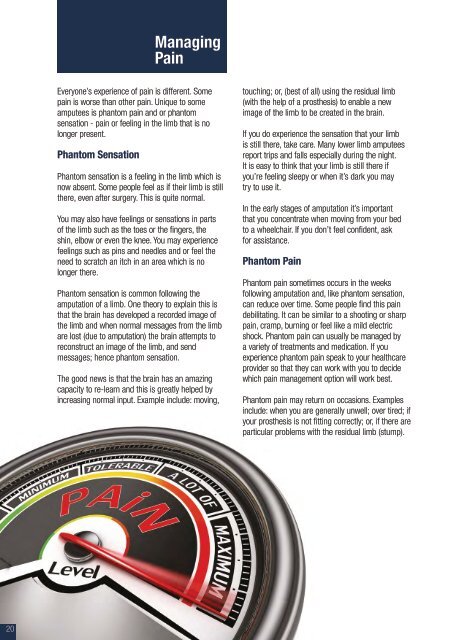A PRACTICAL
A%20Practical%20Guide%20for%20Amputees%20-%20Limbs%204%20Life
A%20Practical%20Guide%20for%20Amputees%20-%20Limbs%204%20Life
You also want an ePaper? Increase the reach of your titles
YUMPU automatically turns print PDFs into web optimized ePapers that Google loves.
Managing<br />
Pain<br />
Everyone’s experience of pain is different. Some<br />
pain is worse than other pain. Unique to some<br />
amputees is phantom pain and or phantom<br />
sensation - pain or feeling in the limb that is no<br />
longer present.<br />
Phantom Sensation<br />
Phantom sensation is a feeling in the limb which is<br />
now absent. Some people feel as if their limb is still<br />
there, even after surgery. This is quite normal.<br />
You may also have feelings or sensations in parts<br />
of the limb such as the toes or the fingers, the<br />
shin, elbow or even the knee. You may experience<br />
feelings such as pins and needles and or feel the<br />
need to scratch an itch in an area which is no<br />
longer there.<br />
Phantom sensation is common following the<br />
amputation of a limb. One theory to explain this is<br />
that the brain has developed a recorded image of<br />
the limb and when normal messages from the limb<br />
are lost (due to amputation) the brain attempts to<br />
reconstruct an image of the limb, and send<br />
messages; hence phantom sensation.<br />
The good news is that the brain has an amazing<br />
capacity to re-learn and this is greatly helped by<br />
increasing normal input. Example include: moving,<br />
touching; or, (best of all) using the residual limb<br />
(with the help of a prosthesis) to enable a new<br />
image of the limb to be created in the brain.<br />
If you do experience the sensation that your limb<br />
is still there, take care. Many lower limb amputees<br />
report trips and falls especially during the night.<br />
It is easy to think that your limb is still there if<br />
you’re feeling sleepy or when it’s dark you may<br />
try to use it.<br />
In the early stages of amputation it’s important<br />
that you concentrate when moving from your bed<br />
to a wheelchair. If you don’t feel confident, ask<br />
for assistance.<br />
Phantom Pain<br />
Phantom pain sometimes occurs in the weeks<br />
following amputation and, like phantom sensation,<br />
can reduce over time. Some people find this pain<br />
debilitating. It can be similar to a shooting or sharp<br />
pain, cramp, burning or feel like a mild electric<br />
shock. Phantom pain can usually be managed by<br />
a variety of treatments and medication. If you<br />
experience phantom pain speak to your healthcare<br />
provider so that they can work with you to decide<br />
which pain management option will work best.<br />
Phantom pain may return on occasions. Examples<br />
include: when you are generally unwell; over tired; if<br />
your prosthesis is not fitting correctly; or, if there are<br />
particular problems with the residual limb (stump).<br />
20




